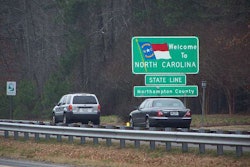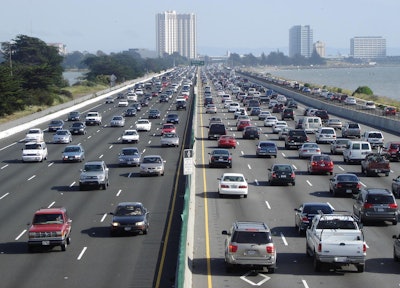
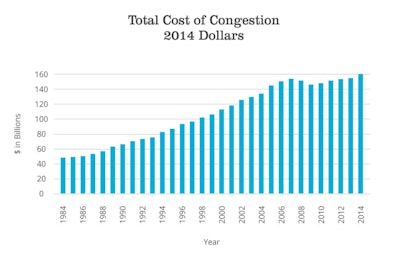
ASCE reviewed the nation’s roads in three categories, including capacity and condition, public safety and innovation and resilience.
Capacity and condition
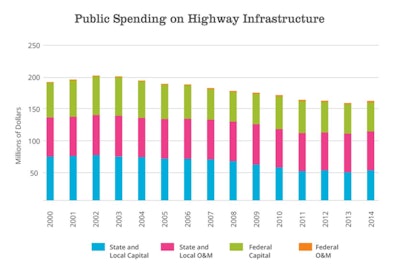
The association points out the near-record number of miles driven on U.S. roads for 2016, which surpassed 3 trillion miles. This contributes to the road congestion problem, ASCE says, with more than two out of every five miles on urban interstates being congested. Americans spent 6.9 billion hours delayed in traffic in 2014, which comes out to 42 hours per driver, and wasted 3.1 billion gallons of fuel. The economic impact is estimated at $160 billion that year.
ASCE also cited highway funding programs, pointing out the federal government spent $43.5 billion on capital costs for highway infrastructure in 2014, with state and local governments spending $48.3 billion. For operation and maintenance, the feds spend $2.7 billion in 2014, with smaller governments spending $70 billion.
While pointing out that the 18.4 cents per gallon federal tax on gasoline and 24.4 cents per gallon federal tax on diesel supplies the Highway Trust Fund, ASCE reports that 17 states and the District of Columbia raised motor fuels taxes between 2013 and 2017. The association sees mileage-based user fees as a good revenue source in the future.
“With continued improvements in vehicle fuel efficiency and the popularity of hybrid and electric vehicles, mileage-based user fees present a promising long- term funding alternative to the motor fuels tax,” ASCE says.
Public Safety
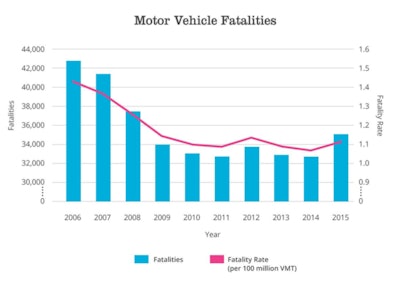
“The recent increase in fatal crashes is not yet fully understood, but communities are trying to save lives through improvements in road design, such as widening lanes and shoulders; adding and improving medians, guard rails, and parallel rumble strips; upgrading road markings and traffic signals; and using new materials, such as high friction surface treatments,” ASCE reports.
Communities also are using the “road diet” process that reduces lanes and adds safety features through road reconfigurations, such as converting a four-lane, undivided highway to a two-lane roadway with a center two-way left-turn lane. The change provides extra space that can used for bike lanes, pedestrian refuge islands or designated transit stops, ASCE says.
Innovation and Resilience
On a positive note, the association points out developments are in the works for new road designs, construction, maintenance and management technologies and techniques.
“The Federal Highway Administration’s Every Day Counts program has played an important role in collecting and evaluating new ideas and promoting the deployment of proven, market-ready strategies,” ASCE reports. “These innovations have included the use of 3D engineered models for more accurate and efficient planning and construction; new methods to determine when, where and how to best preserve pavement; and tools to make permitting reviews faster and more efficient. New materials and technology are also helping roads become more sustainable and resilient, such as greater use of permeable paving materials to reduce storm runoff, as well as the use of recycled materials in pavement.”
Recommendations
To help improve the D grade of U.S. roads, ASCE makes the following recommendations:
- Increase funding from all levels of government and the private sector to tackle the massive backlog of highway needs.
- Fix the federal Highway Trust Fund by raising the federal motor fuels tax. To ensure long-term, sustainable funding for the federal surface transportation program, the current user fee of 18.4 cents per gallon on gasoline and 24.4 cents per gallon on diesel should be raised and tied to inflation to restore its purchasing power, fill the funding deficit, and ensure reliable funding for the future.
- Tackle congestion through policies and technologies that maximize the capacity of the existing road network and create an integrated, multimodal transportation system.
- Prioritize maintenance and the state of good repair to maximize the lifespan of roads.
- State and local governments should ensure their funding mechanisms (motor fuel taxes or other) are sufficient to fund their needed investment.
- All levels of government need to think long-term about how to fund their roads and consider potential alternatives to the motor fuel taxes, including further study and piloting of mileage- based user fees.
- Increase investment and expand the federal Highway Safety Improvement Program to find new ways and further propagate existing methods to make roads safe for all users.
“The grades in the ASCE Report Card provide yet another example of what occurs when a nation underinvests in the critical infrastructure systems that support economic development and quality of life,” says American Association of State Highway and Transportation Officials Executive Director Bud Wright. “The FAST Act, signed into law in 2015, provided a modest increase in federal investment over five years, but it did not solve the long-term funding issues that threaten the future of America’s highway, transit and passenger rail programs. The call for greater infrastructure investment began on the campaign trail and it continues in Washington today. It’s our hope that this report card will help turn that talk into action, prompting lawmakers to pass new legislation to provide long-term sustainable funding for America’s highway and transit programs.”


